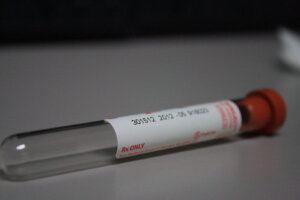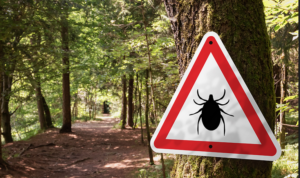 A Lyme disease diagnosis can be frightening, especially if you start to search the internet for information. I spend a lot of time in the woods, and personally was diagnosed with Lyme disease in 2015, and even as a nurse, the misinformation and general information overload can become overwhelming. Everyone is saying something different! Even seemingly credible sources, like news channels, may share misinformation. So, what are the facts about Lyme disease?
A Lyme disease diagnosis can be frightening, especially if you start to search the internet for information. I spend a lot of time in the woods, and personally was diagnosed with Lyme disease in 2015, and even as a nurse, the misinformation and general information overload can become overwhelming. Everyone is saying something different! Even seemingly credible sources, like news channels, may share misinformation. So, what are the facts about Lyme disease?
What is Lyme disease?
Lyme disease is a bacterial infection caused by a bacteria called Borrelia Burgdoferi. The bacteria is passed from blacklegged ticks to humans from a bite. Lyme disease can cause mild to (rarely) more severe illness. The tick must be attached for 48 hours to pass the bacteria on to a human.
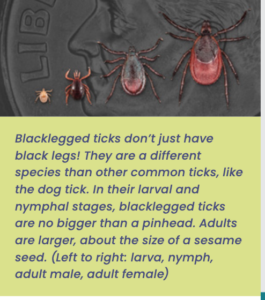
Source: CDC.org publicly available Lyme disease recource material
Did you know? Almost 470,000 people in the US were diagnosed with Lyme disease last year
What are the symptoms of Lyme disease?
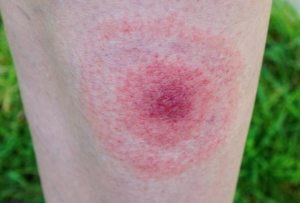
“Bullseye” rash seen in Lyme disease
“Bullseye” style rash around a tick bite
Fatigue (tiredness)
Joint pain
Flu Like symptoms and Fever
Headaches
Facial paralysis/ drooping (Rare)
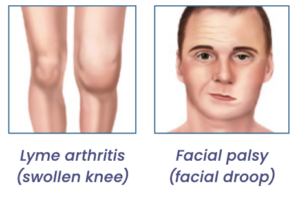
Source: CDC Lyme resources publicly available materials
Heart Problems, like an abnormal slow heartbeat and passing out (rare)
What about all these treatments you see online? What’s real? Whats Misinformation?
If you search for “Lyme disease” on Google, you will see many results. You may have seen blogs and ads for doctors offices offering “chronic Lyme disease” treatment, or videos from other patients about home remedies. The link below features a “Lyme literate” doctor who runs a blog.
https://danielcameronmd.com/what-is-lyme-literate-doctor/
This blog serves as an advertisement for this doctors’s practice, where he treats chronic Lyme disease based on symptoms alone, not tests. He uses a many therapies, including long term antibiotics. This can be a real issue. Read on to see why.
So-How is Lyme disease diagnosed?
If you have a bullseye rash, your doctor or provider will usually diagnose you with Lyme disease based on this symptom alone. This rash only happens in Lyme disease.
-Lyme disease is tested for using blood tests. The first test, called the ELISA, tests for antibodies to Lyme bacteria.
-If this test is positive, the results are confirmed with a second test, called the Western Blot.
According to infectious disease doctors, Lyme disease should never be diagnosed based on symptoms alone. The symptoms of Lyme disease are similar to the symptoms of many other illnesses, and unnecessary treatment with antibiotics could cause other health problems, not to mention a serious health issue could be missed.
(Source: Lantos et. al, 2020)
We all love YouTube, and it can be fun, but YouTube can have a lot of misinformation….
There are many videos about Lyme disease treatments on YouTube.
Look at this example of a news story from Boston. It is one of the first videos you find when searching “Lyme disease” on Youtube:
Here is another video that pops up near the top of the search results on Youtube:
Both of these videos are prime examples of Lyme disease misinformation. Why?
In both short clips, the people featured claim to be suffering from chronic Lyme disease. According to infectious disease doctors, some patients may rarely experience long term symptoms from Lyme disease. These symptoms are usually joint aches and headaches. This does not mean that they are still infected with the bacteria. Treatments like extreme hyperthermia (heat) therapy, which the teen used in the first video,is not a proven, safe or effective treatment for Lyme disease (Source: Lantos et. al, 2015). It can also be dangerous, as in the video the patient’s have their body temperatures raised to potentially deadly levels. In addition, the teen and her family were charged over 60,000 US dollars per day for this treatment!
In the second video, the woman was treating herself with bee stings. According to some infectious disease doctors, this is becoming popular online. This treatment is also unproven and can be dangerous and painful. There are other home remedies seen on the internet, like urine therapy, lasers, oxygen, herbal supplements, drinking bleach solutions, and hormone shots. A team of researchers who looked into these therapies were unable to find any studies or evidence to support them. (Source: Lantos et. al, 2015)
There are safe and effective treatments for Lyme Disease that are covered by insurance.
You are probably asking- how is Lyme disease treated by doctors?
Lyme disease is cured with antibiotics. For most people, this mean a short course (3 to 4 weeks) of antibiotics taken by mouth. For almost all people, symptoms get better with treatment. Usually, the antibiotics used are doxycyline or penicillin.
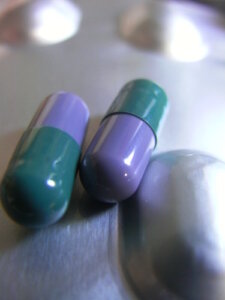
By: List_84
Rarely, some people may experience inflammation of their heart, called Lyme carditis. If this rare condition occurs, antibiotics are given in the hospital by IV line, usually for a week and then followed by oral antibiotics.
For some people, symptoms (like joint aches) may continue after treatment. This does not mean an infection is still present. Long term antibiotics are not recommended for this reason. If symptoms continue, see your doctor or healthcare provider. If Lyme disease is treated early with antibiotics, the chance of developing long term symptoms decreases.
Watch this video to learn more about how Lyme disease is treated:
For more information on Lyme disease, please visit the Centers for Disease Control Lyme Resource page at https://www.cdc.gov/lyme/index.html
The Good news is that you can take steps to prevent Lyme disease. Here’s how:
If you are going outside into wooded areas:
-Wear hats and long pants tucked into boots in wooded areas, in light colors
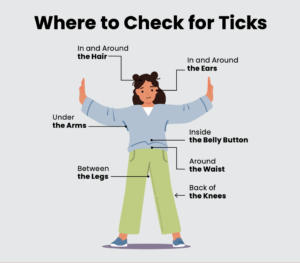
Source: CDC publicly available Lyme disease education resources CDC/org/lyme/recources
-Use a bug spray containing DEET (at least 40%) or picaridin
-After being in a wooded area, remove all clothing and perform a thorough check for ticks.
-If you find a tick, remove it immediately with stiff tweezers, grasping near the tick’s head. Do Not use jelly, oil or cream to massage the tick, as this may further spread Lyme bacteria. If you cannot remove the tick, see medical help at your doctor’s office or walk in clinic.
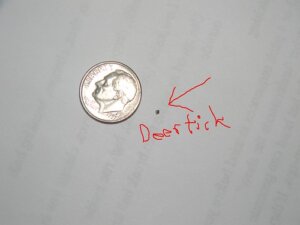
By: Joe’s Famous Coffee
Deer Tick shown next to dime for size reference
-Try to remove ticks as quickly as possible, this can help prevent Lyme disease. If a deer tick was attached for more than 48 hours, see your doctor.
-If you are concerned about a tick bite or any of the symptoms listed on this blog, please see your doctor.
Sources:
Baarsma, M. E., Claassen, S. A., van der Horst, H. E., Hovius, J. W., & Sanders, J. M. (2022). Knowing the entire story – a focus group study on patient experiences with chronic lyme-associated symptoms (chronic lyme disease). BMC Primary Care, 23(1). https://doi.org/10.1186/s12875-022-01736-5
Centers for Disease Control and Prevention. (2023, August 4). Lyme disease educational materials. https://www.cdc.gov/lyme/toolkit/index.html
Halperin, J. J., Baker, P., & Wormser, G. P. (2013). Common misconceptions about lyme disease. The American Journal of Medicine, 126(3), 264.e1–264.e7. https://doi.org/10.1016/j.amjmed.2012.10.008
Lantos, P. M., Rumbaugh, J., Bockenstedt, L. K., Falck-Ytter, Y. T., Aguero-Rosenfeld, M. E., Auwaerter, P. G., Baldwin, K., Bannuru, R. R., Belani, K. K., Bowie, W. R., Branda, J. A., Clifford, D. B., DiMario, F. J., Halperin, J. J., Krause, P. J., Lavergne, V., Liang, M. H., Meissner, H., Nigrovic, L. E.,…Zemel, L. S. (2020). Clinical practice guidelines by the infectious diseases society of america (idsa), american academy of neurology (aan), and american college of rheumatology (acr): 2020 guidelines for the prevention, diagnosis and treatment of lyme disease. Clinical Infectious Diseases, 72(1), e1–e48. https://doi.org/10.1093/cid/ciaa1215
Lantos, P. M., Shapiro, E. D., Auwaerter, P. G., Baker, P. J., Halperin, J. J., McSweegan, E., & Wormser, G. P. (2015). Unorthodox alternative therapies marketed to treat lyme disease. Clinical Infectious Diseases, 60(12), 1776–1782. https://doi.org/10.1093/cid/civ186
Willis, S. J., Cocoros, N. M., Callahan, M., Herrick, B., Brown, C. M., Kruskal, B. A., & Klompas, M. (2022). Assessment of antibiotic prescriptions for lyme disease after modification of reporting language for positive screening test results. JAMA Network Open, 5(1), e2144928. https://doi.org/10.1001/jamanetworkopen.2021.44928

